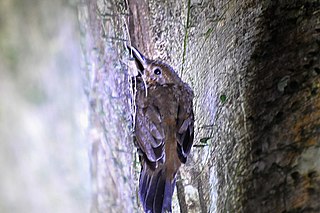
The booted macaque is a macaque of the Sulawesi Island, Indonesia. This Old World monkey is diurnal and spends most of the day in the trees. It is 50–59 cm long plus a tail of 35–40 cm.

The Muna-Buton macaque is one of seven Sulawesi macaques in Indonesia. It is only found on two small islands off the south-east coast: the islands of Buton and Muna. This Old World monkey is diurnal and arboreal, although it can spend significant amounts of time on the ground. It is black with grey "boots" and a brownish colour to the fur on its back. Like other Sulawesi macaques, it has a reduced tail of only about 35mm in length. Its body is about 475 - 495mm in length.

Amanita brunnescens, also known as the brown American star-footed amanita or cleft-footed amanita is a native North American mushroom of the large genus Amanita. It differs from A. phalloides by its fragile volva and tendency to bruise brown.

The pectoral-patch cisticola is a species of bird in the family Cisticolidae. It is found in Cameroon, Republic of the Congo, Democratic Republic of the Congo, Eritrea, Ethiopia, Gabon, Kenya, Somalia and Tanzania. Its natural habitats are damp or wet areas in upland grassland.

The spotted barbtail is a species of bird in the family Furnariidae. Its natural habitat is subtropical or tropical moist montane forest.

The short-billed leaftosser is a species of bird in the subfamily Sclerurinae, the leaftossers and miners, of the ovenbird family Furnariidae. It is found in Bolivia, Brazil, Colombia, Ecuador, French Guiana, Guyana, Peru, Suriname, and Venezuela.

Amanita aestivalis, commonly known as the white American star-footed amanita, is a species of fungus in the mushroom family Amanitaceae. The cap of the white fruit body is 5 to 8.5 centimetres in diameter. It sits atop a stem that is 8.5 to 16 cm long. The entire fruit body will slowly stain a reddish-brown color in response to bruising. A. aestivalis may be a synonym for A. brunnescens, and may be confused with several other white-bodied amanitas. The fungus is distributed in eastern North America.

Hume's bush warbler is a species of bush warbler. It was formerly included in the "Old World warbler" assemblage.
Epilobium brunnescens is a flowering plant belonging to the willowherb genus Epilobium in the family Onagraceae. It is a small, creeping, perennial plant with white or pale pink flowers. It is native to New Zealand and south-east Australia and has been introduced to Northern Europe. Its common names include New Zealand willowherb in Great Britain and Ireland, creeping willowherb in New Zealand and bog willowherb for the Australian subspecies.

Carex brunnescens, the brownish sedge or green bog sedge, is a species of plant in the sedge family (Cyperaceae). It has a circumboreal distribution, and is native to North America and Eurasia. In the United States it is primarily found in the Northeast and Midwest extending south into the Appalachian Mountains, with disjunct populations westward in the Rocky Mountains. It has a wide-ranging natural habitat, is in found in forests, bogs, fens, and rock outcrops.

Phaeomolis brunnescens is a moth of the family Erebidae first described by Walter Rothschild in 1909. It is found in Panama, Brazil and Bolivia.

Sophronica is a genus of longhorn beetles of the subfamily Lamiinae, containing the following species:
Estola brunnescens is a species of beetle in the family Cerambycidae. It was described by Stephan von Breuning in 1940. It is known from Colombia and Venezuela.
Sophronica bimaculipennis is a species of beetle in the family Cerambycidae. It was described by Stephan von Breuning in 1955, originally under the genus Sophronisca. It is known from Ghana, the Ivory Coast, and Guinea. It contains the varietas Sophronica bimaculipennis var. besnardi.
Sophronica rufobasiantennalis is a species of beetle in the family Cerambycidae. It was described by Stephan von Breuning in 1948. It contains the varietas Sophronica rufobasiantennalis var. ovalis.
Sophronica rufulescens is a species of beetle in the family Cerambycidae. It was described by Stephan von Breuning in 1940. It feeds on the Monterey pine.
Sophronica angusticollis is a species of beetle in the family Cerambycidae. It was described by Per Olof Christopher Aurivillius in 1928. It is known from Somalia, Ethiopia, Tanzania, and Kenya.
Sophronica grisea is a species of beetle in the family Cerambycidae. It was described by Per Olof Christopher Aurivillius in 1908.
Sophronica amplipennis is a species of beetle in the family Cerambycidae. It was described by Francis Polkinghorne Pascoe in 1888.
Leucocoprinus brunnescens is a species of mushroom producing fungus in the family Agaricaceae.










